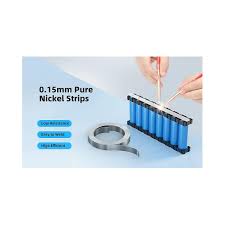Unveiling the Essential Properties and Applications of Nickel Strip
Nickel strip, an indispensable component in various industries, Best price for SMD/SMT Nickel Strip plays a crucial role in modern engineering applications. This article delves into the specific properties, diverse applications, and evolving trends surrounding nickel strip, shedding light on its significance in contemporary manufacturing processes.
Understanding Nickel Strip:
Nickel strip, predominantly composed of nickel and often alloyed with other metals such as copper or chromium, boasts remarkable conductivity, corrosion resistance, and thermal stability. These inherent properties render nickel strip an ideal material for applications demanding reliability, durability, and high-performance efficiency.
Properties of Nickel Strip:
- Conductivity: Nickel strip exhibits excellent electrical conductivity, facilitating its widespread utilization in electrical and electronic devices, battery systems, and power generation equipment.
- Corrosion Resistance: Its resistance to corrosion ensures longevity and reliability, making it suitable for harsh environments and demanding conditions.
- Thermal Stability: Nickel strip maintains its structural integrity and performance under extreme temperatures, making it suitable for applications requiring thermal management and heat dissipation.
Applications of Nickel Strip:
- Battery Manufacturing: Nickel strip serves as a critical component in battery assemblies for electric vehicles (EVs), consumer electronics, and renewable energy systems, enabling efficient energy transfer and storage.
- Electronics Industry: Its conductivity and corrosion resistance make nickel strip an integral part of electronic circuits, connectors, and lead frames in various electronic devices, ensuring seamless functionality and longevity.
- Aerospace and Aviation: Nickel strip finds application in aerospace and aviation industries for its lightweight nature, corrosion resistance, and thermal stability, contributing to the construction of aircraft components, sensors, and electrical systems.
- Industrial Machinery: Nickel strip is utilized in industrial machinery and equipment for its durability and resistance to wear, facilitating reliable performance in heavy-duty applications.
- Medical Devices: In medical device manufacturing, nickel strip is employed for its biocompatibility and reliability, ensuring the integrity of critical components such as pacemakers, defibrillators, and surgical instruments.
Evolving Trends and Future Prospects:
As industries continue to advance technologically, the demand for nickel strip is expected to escalate further. Emerging trends such as the electrification of vehicles, expansion of renewable energy infrastructure, and miniaturization of electronic devices are projected to drive the demand for high-quality nickel strip. Additionally, ongoing research and development efforts focus on enhancing the mechanical properties, recyclability, and sustainability of nickel strip to meet evolving industry standards and environmental regulations.
Conclusion:
Nickel strip stands as a quintessential material in modern engineering, owing to its exceptional properties and diverse applications across industries. As technological innovations continue to shape the industrial landscape, the significance of nickel strip is poised to grow, reaffirming its status as a fundamental component in the advancement of various sectors.

